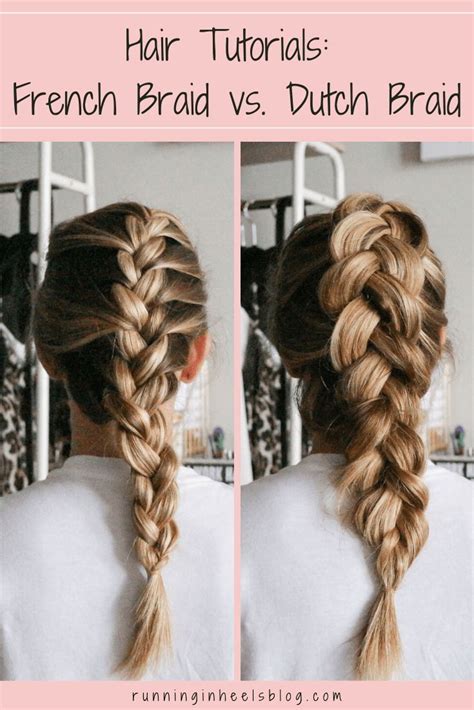Introduction
The world of hairstyling is vast and ever-evolving, with countless techniques and styles to choose from. Among the most popular and versatile braids are Dutch braids and French braids. Both offer unique charm and elegance but differ in their construction, appearance, and suitability for various occasions. This article delves into the intricate details of these two braiding techniques, highlighting their key differences, advantages, and applications.

Defining Dutch and French Braids
Dutch Braids
Dutch braids, also known as “inside-out braids,” are characterized by their inverted weaving pattern. Unlike traditional braids, where the strands are crossed over each other, Dutch braids involve crossing the strands underneath each other. This creates a raised, three-dimensional effect, adding volume and texture to the hair.
French Braids
French braids, on the other hand, are “outside-in braids” that are woven by crossing the strands over each other. They result in a flatter and more intricate pattern, with the strands interwoven close to the scalp. French braids are often adorned with accessories such as ribbons, beads, or flowers to enhance their beauty.
Key Differences
Construction and Appearance:
| Feature | Dutch Braid | French Braid |
|---|---|---|
| Weaving Pattern | Strands cross underneath each other | Strands cross over each other |
| Effect | Raised, three-dimensional | Flatter, intertwined pattern |
| Appearance | Voluminous, textured | Intricate, elegant |
Suitability and Applications:
| Feature | Dutch Braid | French Braid |
|---|---|---|
| Best for | Thick, wavy, or curly hair | All hair types |
| Occasions | Casual, sporty, or bohemian | Formal, elegant, or romantic |
| Applications | Everyday styling, workouts, beach days | Weddings, special events, proms |
Advantages and Disadvantages
Dutch Braids
Advantages:
- Adds volume and texture to hair
- Can be styled in various sizes and patterns
- Ideal for keeping hair out of the face during activities
Disadvantages:
- More time-consuming to braid than French braids
- May be more difficult to master
- Can result in tangles if not braided properly
French Braids
Advantages:
- Intricate and elegant appearance
- Suitable for all hair types
- Can be adorned with accessories for a touch of glamour
Disadvantages:
- May appear flatter than Dutch braids
- Can be more difficult to maintain than Dutch braids
- May be less effective at controlling frizz or flyaways
Step-by-Step Instructions
Dutch Braid
- Divide: Section off a small portion of hair at the crown.
- Cross Under: Cross the right strand under the middle strand.
- Add Right: Add a small piece of hair from the right to the right strand.
- Cross Left: Cross the left strand under the new middle strand.
- Add Left: Add a small piece of hair from the left to the left strand.
- Continue: Repeat steps 2-5, adding strands from the sides as you go.
- Secure: Secure the end with an elastic band.
French Braid
- Divide: Section off a small portion of hair at the crown.
- Cross Over: Cross the right strand over the middle strand.
- Add Right: Add a small piece of hair from the right to the right strand.
- Cross Left: Cross the left strand over the new middle strand.
- Add Left: Add a small piece of hair from the left to the left strand.
- Continue: Repeat steps 2-5, adding strands from the sides as you go.
- Secure: Secure the end with an elastic band.
Tips and Tricks
For Dutch Braids:
- Use a comb to detangle hair before braiding.
- Braid on slightly damp hair for better hold.
- Pull the strands taut as you braid to create volume.
- Experiment with different sizes and patterns for unique looks.
For French Braids:
- Section off the hair carefully to avoid bumps or lumps.
- Keep the strands close to the scalp for an intricate effect.
- Use hairspray or mousse to smooth flyaways.
- Adorn with ribbons or accessories to enhance the elegance.
Tables for Quick Reference
Table 1: Characteristics of Dutch and French Braids
| Feature | Dutch Braid | French Braid |
|---|---|---|
| Weaving Pattern | Inside-out | Outside-in |
| Effect | Raised, textured | Flat, intricate |
| Appearance | Voluminous | Elegant |
| Best for | Thick, wavy hair | All hair types |
Table 2: Advantages and Disadvantages of Dutch Braids
| Advantage | Disadvantage |
|---|---|
| Adds volume and texture | Time-consuming |
| Various sizes and patterns | Difficult to master |
| Ideal for activities | Can result in tangles |
Table 3: Advantages and Disadvantages of French Braids
| Advantage | Disadvantage |
|---|---|
| Intricate and elegant | May appear flatter |
| Suitable for all hair types | Can be difficult to maintain |
| Can be adorned with accessories | Less effective at controlling frizz |
Table 4: Steps for Dutch and French Braids
| Step | Dutch Braid | French Braid |
|---|---|---|
| 1 | Divide hair | Divide hair |
| 2 | Cross under | Cross over |
| 3 | Add from right | Add from right |
| 4 | Cross left | Cross left |
| 5 | Add from left | Add from left |
| 6 | Repeat | Repeat |
| 7 | Secure | Secure |
Conclusion
Dutch braids and French braids offer distinct styles and versatility that cater to different preferences and occasions. Dutch braids add volume and texture, while French braids provide an elegant and intricate look. Both techniques require practice to perfect but can be mastered with patience and dedication. By understanding the differences, advantages, and applications of these two braiding techniques, individuals can choose the perfect style to enhance their personal flair and complement their hair texture.
